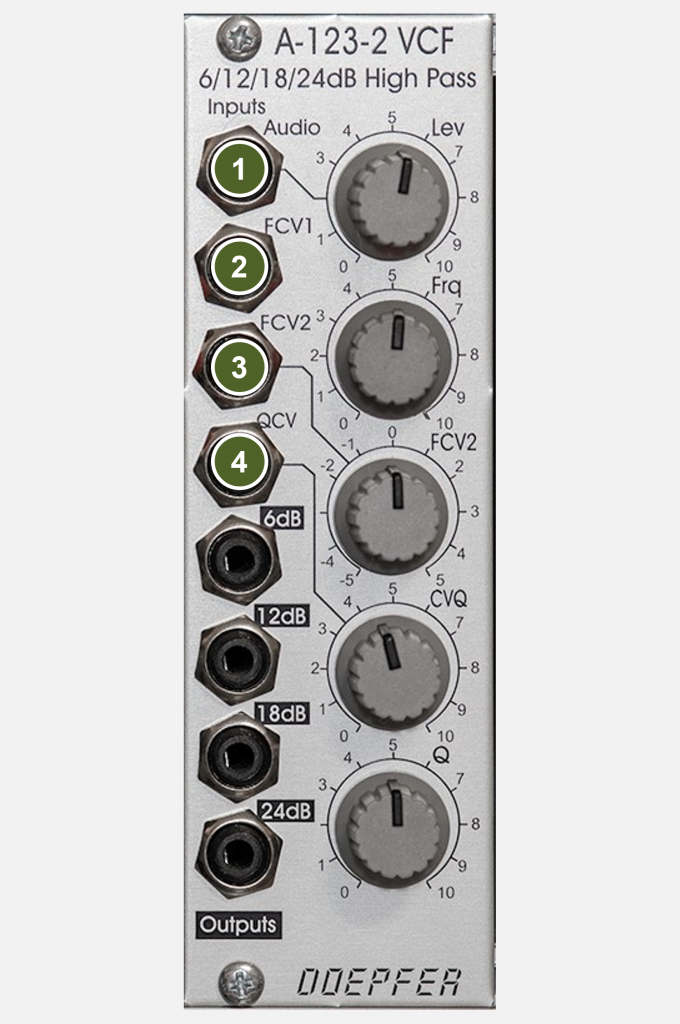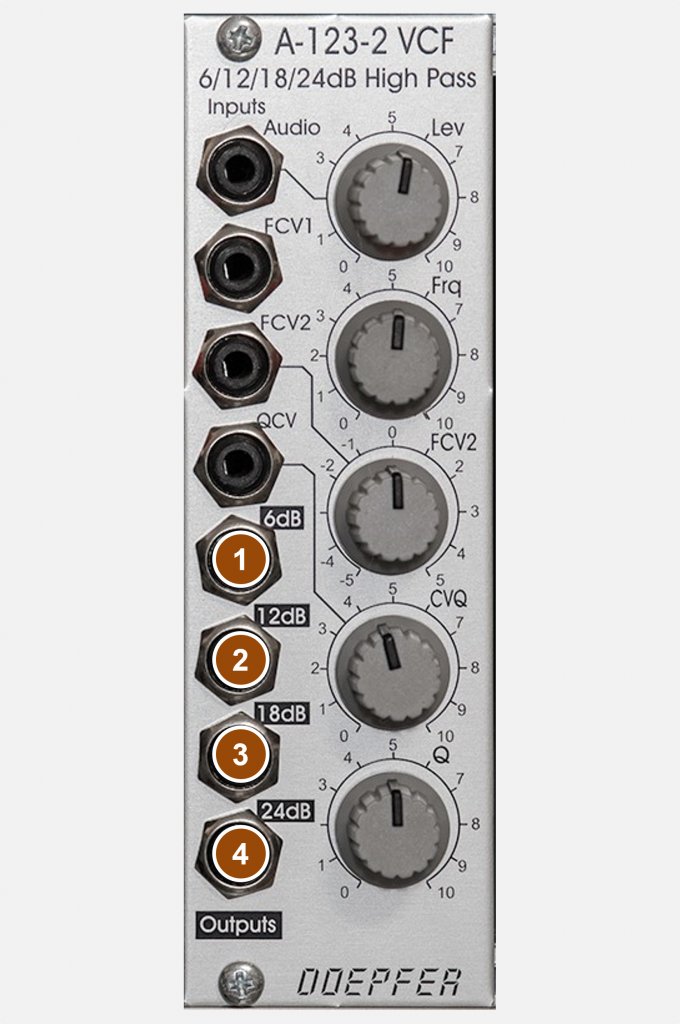After the Curtis chip CEM3320 was no longer available, Doepfer had to stop production of the A-123 24 dB highpass filter. It’s a pity, because there were simply no other 24 dB high-pass filters on the market!
In the meantime, however, a replica is available with the AS3320, so that there is now a 24 dB, no forgiveness, a 24 dB or 18 dB or 12 dB or 6 dB high-pass filter at Doepfer. Apart from the additional individual outputs for the various edge steepnesses, the options and controls of the A-123 have been adopted 1:1 in the new module. The “CV2” controller for the control voltage input has now also been designed to be bipolar, so that you can, for example, invert an envelope directly on the filter.
User interface
Inputs:

- Audio In: Audio input.
- FCV1: Control voltage input for the cutoff-frequency (without attenuator).
- FCV2: Control voltage input for the corner frequency (with attenuator “FCV”).
- QCV: Control voltage input for the resonance of the filter (with attenuator “QCV”).
Outputs:

- 6dB: Audio output of the filter with 6 dB slope.
- 12dB: Audio output of the filter with 12 dB slope.
- 18dB: Audio output of the filter with 18 dB slope.
- 24dB: Audio output of the filter with 24 dB slope.
Controls:

- Lev.: Attenuator for the audio input.
- Frq: Controller for the cutoff-frequency.
- FCV2: Attenuator for the control voltage input “FCV2” (for the cutoff-frequency of the filter). The controller is bipolar, so the control voltage signal is inverted to the left of the controller value “0”.
- CVQ: Attenuator for the control voltage input “QCV” (for the resonance of the filter).
- Q: Filter resonance controller.
Possible uses
As with the predecessor A-123, you can of course give the sound a decent bass foundation by skilfully choosing the cut-off frequency in the low range and decent resonance (“Q”). The trick probably comes from MS-20 users, who used its resonant HP/LP combination skilfully for very full-sounding basses.
But the new A-123-2 can do even more with its different edge steepness. A 6 dB high pass (with little resonance) sets in very subtly. This is worthwhile if the basic material is rather noisy, such as added noise or FM sounds.
With high resonance and low edge steepness, the self-oscillation of the filter becomes much more dominant than with a high edge steepness, as we exclusively found in the predecessor (only 24 dB).
Sound examples
-
A-123-2 / Different edge steepness
It’s not every day you get a high-pass filter with different slopes (24 dB, 18 dB, 12 dB and 6 dB). How much do they really differ?
Again the sawtooth waves of our three A-110-1 VCOs are used, one VCO is again transposed 1 octave down. Only a single tone is triggered at a time, with a slow ADSR envelope modulating the filter cutoff frequency from bottom to top and back again (and also the A-132-3 VCA). An A-152 helps me manually switch between the four filter outputs. In each pass we first hear the 24 dB, then the 18 dB, the 12 dB and finally the 6 dB output.
Input level 5, Q = 0. Input level 5, Q = 5. Input level 5, Q = 10. Input level 10, Q = 0. Input level 10, Q = 5. Input level 10, Q = 10. -
A-123, A-123-2 / Comparison of versions
Since the A-123-2 is the successor to the (rarely available) A-123, the question arises as to whether the two modules differ significantly. First of all: The differences seem to me to be rather marginal and probably come from different fine-tuning of the modules.
As input material I use again 3 A-110-1 VCOs with their sawtooth oscillations, one of them is transposed 1 octave down. The mix goes equally into the A-123 and A-123-2 filters. The self-resonance of both filters was previously tuned to the same pitch. Both filters and the downstream A-132-3 VCAs are modulated by the same A-140 ADSR.
We hear the A-123 filter on the left and the A-123-2 filter on the right.
- I start with an input level of 5 (which shouldn’t distort yet) and a resonance (or “Q” on the A-123-2) of 0. While a simple arpeggio is playing, I manually drive the filter cutoff frequency from bottom to top and back – voltage controlled for both filters so that the cutoff frequencies are roughly parallel.
- In the second pass, the input level is 5 again, but the resonance is increased to 5. Again the manual filter sweep from bottom to top and back.
- In the third pass, the input level is still at 5, but the resonance is increased to 10 – same filter sweep as before.
- Fourth pass: input level is now 10, resonance reduced to 0 again, same filter sweep as before.
- Fifth pass: input level 10, resonance 5, filter sweep.
- Sixth pass: input level 10, resonance 10, filter sweep.
- Finally, I run the filter sweep again with resonance 10, but without an input signal (level = 0) to demonstrate pure natural resonance.
Left: A-123, right: A-123-2. The 24 dB output of the A-123-2 is used for comparison.
Technical specifications
| Width | 8 HP |
| Depth | 45 mm |
| Power requirements | 30 mA (+12V) / -30 mA (-12V) |
